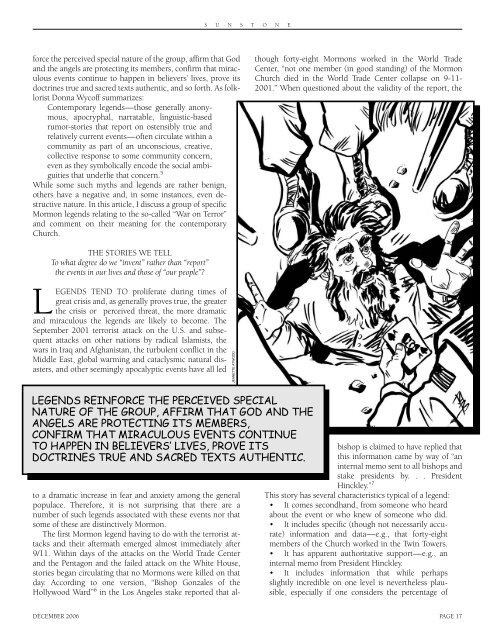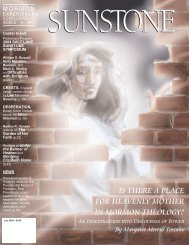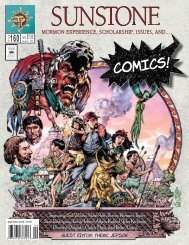Download Entire Issue PDF - Sunstone Magazine
Download Entire Issue PDF - Sunstone Magazine
Download Entire Issue PDF - Sunstone Magazine
You also want an ePaper? Increase the reach of your titles
YUMPU automatically turns print PDFs into web optimized ePapers that Google loves.
S U N S T O N E<br />
force the perceived special nature of the group, affirm that God<br />
and the angels are protecting its members, confirm that miraculous<br />
events continue to happen in believers’ lives, prove its<br />
doctrines true and sacred texts authentic, and so forth. As folklorist<br />
Donna Wycoff summarizes:<br />
Contemporary legends—those generally anonymous,<br />
apocryphal, narratable, linguistic-based<br />
rumor-stories that report on ostensibly true and<br />
relatively current events—often circulate within a<br />
community as part of an unconscious, creative,<br />
collective response to some community concern,<br />
even as they symbolically encode the social ambiguities<br />
that underlie that concern. 5<br />
While some such myths and legends are rather benign,<br />
others have a negative and, in some instances, even destructive<br />
nature. In this article, I discuss a group of specific<br />
Mormon legends relating to the so-called “War on Terror”<br />
and comment on their meaning for the contemporary<br />
Church.<br />
to a dramatic increase in fear and anxiety among the general<br />
populace. Therefore, it is not surprising that there are a<br />
number of such legends associated with these events nor that<br />
some of these are distinctively Mormon.<br />
The first Mormon legend having to do with the terrorist attacks<br />
and their aftermath emerged almost immediately after<br />
9/11. Within days of the attacks on the World Trade Center<br />
and the Pentagon and the failed attack on the White House,<br />
stories began circulating that no Mormons were killed on that<br />
day. According to one version, “Bishop Gonzales of the<br />
Hollywood Ward” 6 in the Los Angeles stake reported that although<br />
forty-eight Mormons worked in the World Trade<br />
Center, “not one member (in good standing) of the Mormon<br />
Church died in the World Trade Center collapse on 9-11-<br />
2001.” When questioned about the validity of the report, the<br />
THE STORIES WE TELL<br />
To what degree do we “invent” rather than “report”<br />
the events in our lives and those of “our people”?<br />
LEGENDS TEND TO proliferate during times of<br />
great crisis and, as generally proves true, the greater<br />
the crisis or perceived threat, the more dramatic<br />
and miraculous the legends are likely to become. The<br />
September 2001 terrorist attack on the U.S. and subsequent<br />
attacks on other nations by radical Islamists, the<br />
wars in Iraq and Afghanistan, the turbulent conflict in the<br />
Middle East, global warming and cataclysmic natural disasters,<br />
and other seemingly apocalyptic events have all led<br />
LEGENDS REINFORCE THE PERCEIVED SPECIAL<br />
NATURE OF THE GROUP, AFFIRM THAT GOD AND THE<br />
ANGELS ARE PROTECTING ITS MEMBERS,<br />
CONFIRM THAT MIRACULOUS EVENTS CONTINUE<br />
TO HAPPEN IN BELIEVERS’ LIVES, PROVE ITS<br />
DOCTRINES TRUE AND SACRED TEXTS AUTHENTIC.<br />
JEANETTE ATWOOD<br />
bishop is claimed to have replied that<br />
this information came by way of “an<br />
internal memo sent to all bishops and<br />
stake presidents by. . . President<br />
Hinckley.” 7<br />
This story has several characteristics typical of a legend:<br />
• It comes secondhand, from someone who heard<br />
about the event or who knew of someone who did.<br />
• It includes specific (though not necessarily accurate)<br />
information and data—e.g., that forty-eight<br />
members of the Church worked in the Twin Towers.<br />
• It has apparent authoritative support—e.g., an<br />
internal memo from President Hinckley.<br />
• It includes information that while perhaps<br />
slightly incredible on one level is nevertheless plausible,<br />
especially if one considers the percentage of<br />
DECEMBER 2006 PAGE 17

















